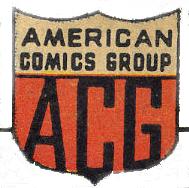Related Research Articles

Quality Comics was an American comic book publishing company which operated from 1937 to 1956 and was a creative, influential force in what historians and fans call the Golden Age of Comic Books.
Fawcett Comics, a division of Fawcett Publications, was one of several successful comic book publishers during the Golden Age of Comic Books in the 1940s. Its most popular character was Captain Marvel, the alter ego of radio reporter Billy Batson, who transformed into the hero whenever he said the magic word "Shazam!".

American Comics Group (ACG) was an American comic book publisher started in 1939 and existing under the ACG name from 1943 to 1967. It published the medium's first ongoing horror-comics title, Adventures into the Unknown. ACG's best-known character was the 1960s satirical-humor hero Herbie Popnecker, who starred for a time in Forbidden Worlds. Herbie would later get his own title and be turned into a "superhero" called the Fat Fury.
Michael Anglo was a British comic book writer, editor and artist, as well as an author. He was best known for creating the superhero Marvelman, later known as Miracleman.

Michael Sekowsky was an American comics artist known as the penciler for DC Comics' Justice League of America during most of the 1960s, and as the regular writer and artist on Wonder Woman during the late 1960s and early 1970s.

Atlas Comics was the 1950s comic-book publishing label that evolved into Marvel Comics. Magazine and paperback novel publisher Martin Goodman, whose business strategy involved having a multitude of corporate entities, used Atlas as the umbrella name for his comic-book division during this time. Atlas evolved out of Goodman's 1940s comic-book division, Timely Comics, and was located on the 14th floor of the Empire State Building. This company is distinct from the 1970s comic-book company, also founded by Goodman, that is known as Atlas/Seaboard Comics.

Fiction House was an American publisher of pulp magazines and comic books that existed from the 1920s to the 1950s. It was founded by John B. "Jack" Kelly and John W. Glenister. By the late 1930s, the publisher was Thurman T. Scott. Its comics division was best known for its pinup-style good girl art, as epitomized by the company's most popular character, Sheena, Queen of the Jungle.

Aaron A. Wyn, born Aaron Weinstein, was an American publisher.

Avon Publications is one of the leading publishers of romance fiction. At Avon's initial stages, it was an American paperback book and comic book publisher. The shift in content occurred in the early 1970s with multiple Avon romance titles reaching and maintaining spots in bestseller lists, demonstrating the market and potential profits in romance publication. As of 2010, Avon is an imprint of HarperCollins.
Magazine Publishers was a pulp magazine publishing house established by Harold Hersey and later owned by A. A. Wyn in 1929. Under Wyn, it was known as "Ace Magazines", hence titles such as Ace Mystery and Ace Sports. They also used the name "Periodical House", and also branched out to publishing comic books as Ace Comics. In the 1940s the company also began publishing books.

Magazine Enterprises was an American comic book company lasting from 1943 to 1958, which published primarily Western, humor, crime, adventure, and children's comics, with virtually no superheroes. It was founded by Vin Sullivan, an editor at Columbia Comics and before that the editor at National Allied Publications, the future DC Comics.
Howard Peter Tumlinson was an American comic book artist whose work appeared from the late 1940s through the 1950s in titles published by the Marvel Comics predecessors Timely Comics and Atlas Comics, and a book illustrator. His comics work includes most of the early stories of the Western hero Kid Colt.
Lash Lightning is a fictional superhero character who first appeared in Sure-Fire Comics #1 from Ace Comics, which was renamed Lightning Comics with issue #4 to take advantage of the new character's popularity. Originally called Flash Lightning, the character's name was changed to Lash Lightning in issue #7 to avoid confusion with DC Comics' the Flash.
Toby Press was an American comic-book company that published from 1949 to 1955. Founded by Elliott Caplin, brother of cartoonist Al Capp and himself an established comic strip writer, the company published reprints of Capp's Li'l Abner strip; licensed-character comics starring such film and animated cartoon properties as John Wayne and Felix the Cat; and original conceptions, including romance, war, Western, and adventure comics. Some of its comics were published under the imprint Minoan. Some covers bore the logo ANC, standing for American News Company, at the time the country's largest newsstand distributor.
Key Publications was an American comic-book company founded by Stanley P. Morse that published under the imprints Aragon Magazines, Gillmor Magazines, Medal Comics, Media Publications, S. P. M. Publications, Stanmor Publications, and Timor Publications.

Thorpe & Porter was a British publisher, importer, and distributor of magazines and comic books. At first, the company was known for repackaging American comics and pulp magazines for the UK market. Later on, it became a publisher of original material. The company released more than 160 comics titles in the UK, the most prominent being Classics Illustrated, MAD UK, Edgar Rice Burroughs' Tarzan of the Apes, Larry Harmon's Laurel & Hardy, House of Hammer, and Forbidden Worlds. T & P's most prominent imprints were Top Sellers Ltd. and Brown Watson. Thorpe & Porter operated from 1946 to c. 1979.
References
- 1 2 3 Ace Magazines at the Grand Comics Database
- ↑ Magno and Davey at Don Markstein's Toonopedia. Archived from the original on March 21, 2015.
- ↑ "Magno (Ace Magazines)". Write Ups. July 25, 2019.